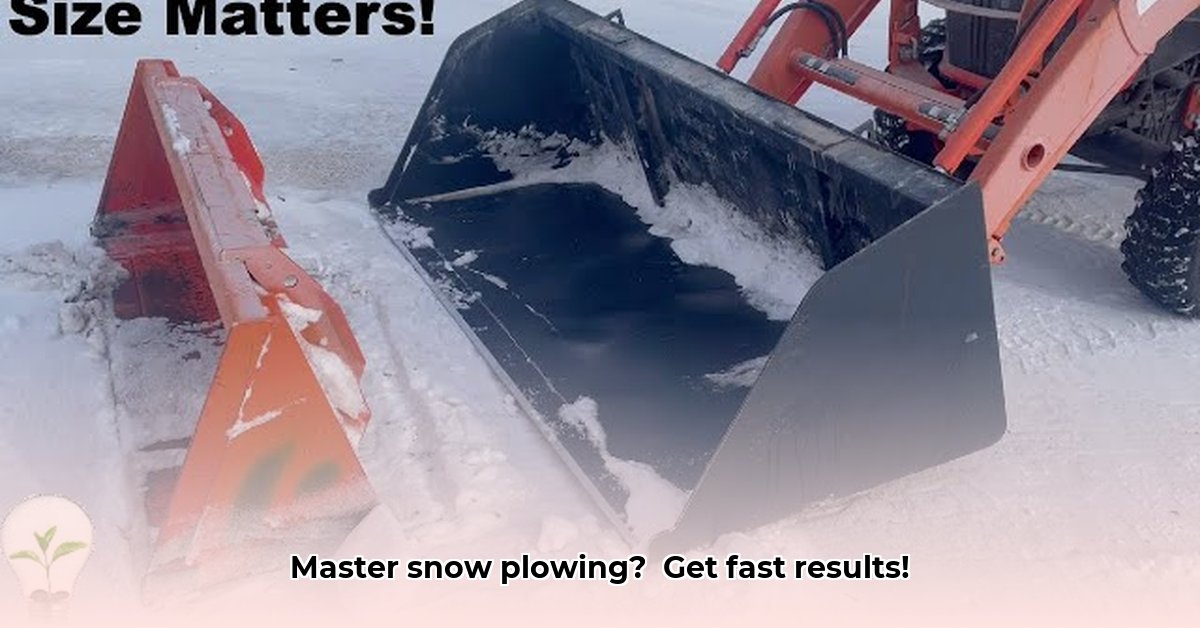
Plowing Snow with a Tractor Bucket: A Step-by-Step Guide
Winter's arrived, and with it comes the inevitable chore of snow removal. If you own a tractor and bucket, you have a powerful tool at your disposal. However, effective and safe snow plowing requires more than just hopping on and going. This guide provides a step-by-step approach to mastering the art of snow removal with your tractor bucket, ensuring efficient and safe results. We'll cover everything from pre-plowing prep to advanced techniques and troubleshooting common problems. Are you ready to conquer winter's white blanket? For more information on tractor attachments, check out this helpful resource: Kubota Tractor Snow Plows.
Getting Ready: Pre-Plowing Prep Work (Essential Steps for Safety and Efficiency)
Before you even start the engine, preparing your equipment and assessing the snow conditions is crucial for optimal results and safety. This pre-plowing checklist ensures a smooth and efficient snow removal process.
Tractor Inspection: Begin with a thorough inspection of your tractor. Check fluid levels (engine oil, coolant, hydraulic fluid), ensuring they’re topped off. Inspect belts and hoses for any signs of wear or damage. Proper maintenance is essential not only for optimal performance but also for safety. A malfunctioning tractor can lead to significant issues.
Bucket Check: Carefully examine your bucket for any dents, cracks, or loose bolts. Replace or repair any damage before you begin plowing. A damaged bucket can significantly reduce effectiveness and even pose a safety risk.
Snow Assessment: Before you start, take a moment to assess the snow conditions. Is the snow light and fluffy, or heavy and wet? This assessment helps determine your plowing strategy. Light, fluffy snow requires a different approach than heavy, wet snow.
Clear the Area: Ensure the area you will be plowing is free of obstacles such as rocks, debris, or hidden ice patches. Remove any potential hazards to prevent damage to your equipment or injury to yourself.
Mastering the Art of Snow Removal: Techniques for Success
The key to efficient snow plowing lies in the technique. Following these steps will minimize time and effort while maximizing safety.
Start Slowly, Gradually Increase Speed: This is crucial for both safety and efficiency. Beginning at a slow speed allows you to get a feel for the tractor and the snow conditions. Gradually increase your speed as you become more comfortable.
Adjust Your Bucket Angle: The bucket angle significantly impacts snow removal efficiency. A shallow angle is ideal for moving large volumes of snow quickly. A steeper angle works better for smaller amounts or for directing snow to a specific area. Experimentation is key to determining the optimal angle for your situation.
Overlap Your Passes: Prevent leaving unplowed patches by slightly overlapping each pass. This ensures thorough snow removal and a clean finish. Consistent overlaps prevent incomplete snow removal and improve efficacy.
Maintain Consistent Momentum: Avoid frequent stopping and starting, as this is both less efficient and harder on your tractor. Maintaining a consistent pace minimizes wear and tear and greatly improves overall operation speed.
Navigate Obstacles Safely: When approaching obstacles, reduce the speed significantly. Be highly vigilant and maintain optimal control of your tractor and bucket. Never hesitate to make multiple passes to navigate challenging areas.
Adapt to Snow Depth: The ideal approach varies based on the depth of the snow. For particularly deep snow, shorter passes reduce the strain on the tractor and minimize the risk of getting stuck. Efficiency may be reduced slightly.
Level Up Your Snow-Plowing Game: Advanced Techniques
For those seeking to optimize their snow removal process, these advanced techniques can significantly improve efficiency.
The Windrow Method: This technique involves piling the snow into long, neat rows (windrows) instead of just pushing it to the side. It's particularly useful for large areas, making snow disposal easier, and allowing for better organization of the cleared space.
Consider a V-Plow (optional): Whilst this guide focuses on bucket plowing, it’s important to note that a V-plow attachment provides significantly enhanced efficiency for wide open areas and large snow volumes. Using a V-plow will often cut the time spent significantly.
Safety First: Protecting Yourself and Your Machine
Safety is non-negotiable. Always prioritize safety measures to ensure a safe and productive snow removal process.
Appropriate Clothing: Wear warm layers, gloves, and protective eyewear. Appropriate attire is crucial for protecting against the cold and potential hazards.
Awareness of Surroundings: Exercise caution near roads and other people. Maintain a safe distance and be fully aware of your surroundings at all times.
Physical and Mental State: Never operate the tractor when tired or unwell. Fatigue and impairment significantly increase the risk of accidents.
Regular Maintenance: Regular maintenance is paramount for optimal performance and safety. This includes routine inspection, cleaning, and fluid checks.
Common Problems and Solutions: Troubleshooting Guide
Even experienced operators may encounter issues. This section provides solutions for common problems.
| Problem | Possible Cause | Solution |
|---|---|---|
| Bucket not picking up snow | Incorrect angle, frozen snow, clogged bucket | Adjust angle, use de-icer (if safe), clear bucket thoroughly |
| Tractor slipping | Icy conditions, worn tires | Use tire chains (if appropriate), reduce speed |
| Hydraulic issues | Low fluid levels, system malfunction | Check fluid levels, seek professional help if needed |
Remember, practice refines technique and familiarity. Consistent practice will help you perfect your snow plowing technique, making winter snow removal more efficient and hassle-free.